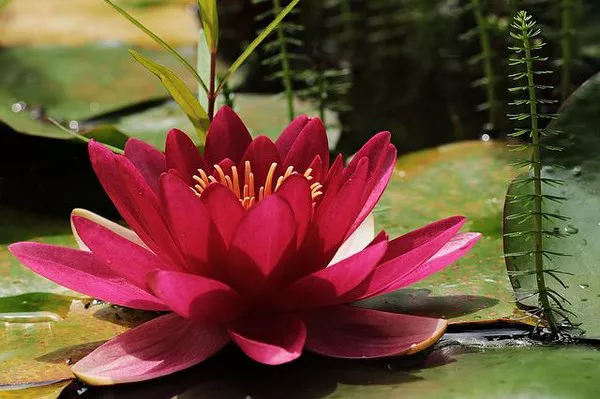In the serene and captivating realm of aquatic ecosystems, lily pads stand as iconic symbols of tranquility and natural beauty. Adorning the surfaces of ponds, lakes, and slow-moving streams, these floating green pads are not just decorative elements; they also harbor a secret treasure that adds an extra layer of enchantment – the delicate and captivating lily pad flowers. In this article, we embark on a journey to uncover the mysteries surrounding the flowers that grace these floating platforms, exploring their types, characteristics, and the unique role they play in the ecosystems they inhabit.
The Botanical Wonders on Lily Pads:
Lily pad flowers, scientifically known as Nymphaea, belong to the family Nymphaeaceae. These aquatic plants boast a remarkable adaptation to life on the water’s surface, with their round, flat leaves providing a platform for the enchanting flowers to bloom. Unlike typical land-based flowers, lily pad flowers exhibit unique adaptations to thrive in aquatic environments.
Types of Lily Pad Flowers:
The world of lily pad flowers is diverse, with various species exhibiting distinctive features and characteristics. One of the most well-known species is the Nymphaea odorata, commonly referred to as the American white water lily. This species is native to North America and is celebrated for its pristine white blossoms that exude a sweet fragrance.
Another notable variety is the Nymphaea caerulea, also known as the blue lotus or blue water lily. Indigenous to Egypt, this species features striking blue or violet-hued flowers, captivating onlookers with its vibrant coloration. In addition to these, there are numerous other species, each with its unique colors, shapes, and sizes, contributing to the overall splendor of lily pad-covered water bodies.
Adaptations for Aquatic Living:
The anatomy of lily pad flowers reflects their aquatic lifestyle. These flowers have evolved to thrive in water, with adaptations that set them apart from their terrestrial counterparts. The long stems of lily pad flowers allow them to reach the water’s surface, where they unfold their captivating blossoms. The leaves, or pads, serve as a crucial support structure for the flowers, enabling them to remain elevated above the waterline.
Furthermore, lily pad flowers have specialized structures to facilitate reproduction in aquatic environments. Their seeds are often contained within a protective pod, which becomes buoyant as the seeds mature. This adaptation allows the seeds to float and disperse across the water, aiding in the colonization of new areas within the aquatic habitat.
Ecological Importance:
Beyond their aesthetic appeal, lily pad flowers play a vital role in the ecosystems they inhabit. These aquatic plants contribute to the overall health and balance of their environments in several ways. The broad leaves of lily pads provide shade, creating cooler areas in the water and offering refuge for fish, amphibians, and other aquatic organisms seeking relief from the sun.
Additionally, lily pads play a role in nutrient cycling. Their roots absorb nutrients from the water, helping to control excess nutrients that could otherwise lead to algal blooms and other ecological imbalances. The presence of lily pads can enhance water quality by acting as natural filters, promoting a healthier and more sustainable aquatic ecosystem.
Cultural Significance:
Lily pad flowers have not only captivated biologists and ecologists but also hold cultural significance in various societies around the world. In many Eastern cultures, the lotus flower, a close relative of the lily pad, is revered as a symbol of purity, enlightenment, and rebirth. The stunning blooms emerging from the water’s depths symbolize the journey towards spiritual awakening, transcending the challenges of life.
In Western cultures, lily pad flowers have been featured in art, literature, and folklore, often representing themes of beauty, serenity, and transformation. Monet’s famous water lily paintings, for example, immortalize the ethereal allure of these flowers, capturing their timeless beauty on canvas.
Conservation Challenges:
Despite their ecological importance and cultural significance, lily pad flowers face threats from human activities and environmental changes. Habitat destruction, pollution, and climate change can adversely impact the delicate balance of aquatic ecosystems, jeopardizing the survival of these captivating flowers.
Conservation efforts are crucial to preserving the habitats where lily pad flowers thrive. Initiatives such as wetland restoration, water quality management, and public awareness campaigns can contribute to the protection of these remarkable aquatic plants and the ecosystems they support.
See Also What Flowers Are Deadly To Cats
Conclusion:
In the heart of serene water bodies, beneath the shade of floating lily pads, a hidden world of enchanting beauty awaits discovery. Lily pad flowers, with their unique adaptations and diverse species, add a touch of magic to aquatic ecosystems. Beyond their visual appeal, these flowers play a crucial role in maintaining ecological balance and serve as symbols of cultural significance.
As we continue to explore and appreciate the wonders of the natural world, let us not forget to cherish and protect these botanical gems. Through conservation efforts and a deeper understanding of their importance, we can ensure that lily pad flowers continue to grace the water’s surface, captivating our hearts and inspiring awe for generations to come.


